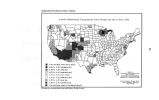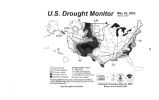| OCR Text |
Show 74 critical stream or riparian habitats with restoration efforts. Restoring these degraded critical stream segments will not only increase habitat, and in many cases water quantity and quality for fish, but will provide deep holes in the stream channel to provide water for numerous aquatic species in times of drought This will allow species to quickly recover as stream flows recover, The restored riparian cover will also provide shade for the stream and mod, cover, and water for the endemic wildlife species, Ponds can be built away from the streams aad developed to provide water for wildlife, benefiting them in times of drought as well as in times of normal weather. Food and cover plots can be planted for numerous wildlife species. Question 4, What is the current status of drought monitoring and data eoltectioa in the NRCS? NRCS currently has about 660 automated SNOTEL sites and 1,200 manual snow courses. Almost all of the 660 SNOTEL sites need replacement of obsolescent radio transmission equipment and upgrading for soil moisture sensor sensing. The snow courses need to be completely automated. Most of the SNOTEL sites need to have a full regimen of climatic sensors, including solar radiation, relative humidity, and wind to support the growing demand for more sophisticated streamflow models. The SCAN has been deployed as a national network. NRCS has deteimined mat an effective national automated soil moisture and temperature monitoring system would require about 2,000 SCAN stations. There are currently 68 SCAN sites located in 37 states. This sparse network is currently used to provide drought analysis, irrigation water management, crop production, disease and pest control management and risk assessment, and assist water resources research by Agricultural Research Service and others. Each SCAN site has a full soil characterization, which enables the users to identify how much soil moisture is available, what type of crop can be planted, and what yields can be expected. This automated information system could provide a sound scientific basis for drought risk assessment Question S, The National Drought Policy Commission, in its May 2000 report to Congress, stated five goals, one of which is to " improve collaboration among scientists and managers to enhance the effectiveness of observation networks, monitoring, prediction, information delivery, and applied research and to faster public understanding of and preparedness for drought." What specific initiatives has your agency prepared to respond to this goal and to improve drought monitoring and data collection? Collaborative efiforts are underway with Department of Commerce National Oceanic and Atmospheric Administration ( NOAA) to develop a prototype Ihtemet- based climate access system. This system will provide me public with climate data and inforo » ation critical for drought risk assessment. NRCS proposes to fully automate the manual snow course system, enhance the SNOTEL data collection system to include soil moisture and temperature sensing, to improve water supply |


























































































